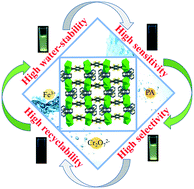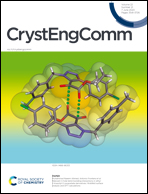A water-stable terbium metal–organic framework with functionalized ligands for the detection of Fe3+ and Cr2O72− ions in water and picric acid in seawater†
Abstract
The existence of Cr2O72− anions and excessive Fe3+ cations in water and picric acid in seawater causes irreversible harm to human health and aquatic organisms. Herein, a water-stable terbium metal–organic framework (namely Tb-MOF-A) was fabricated from 1,10-phenanthroline (phen) and 2,3,5,6-tetrafluoroterephthalic acid (H2tftba) under hydrothermal conditions. Due to the features of the pyridine- and fluorine-functionalized organic ligands and Tb3+ ions, Tb-MOF-A can quickly, quantitatively and circularly detect Cr2O72− anions and Fe3+ cations in a water environment and picric acid in a simulated seawater environment. In addition, the stability studies exhibit excellent water stability and fluorescent stability for 21 days, thermal stability and fluorescent stability in water (−18 °C to 50 °C), and acid-basic solution stability and fluorescent stability (pH = 2–11) for 4 days. Novel Tb-MOF-A is expected to be applied in practical water environment engineering as an excellent sensor with high water-stability, sensitivity, and reusability.



 Please wait while we load your content...
Please wait while we load your content...